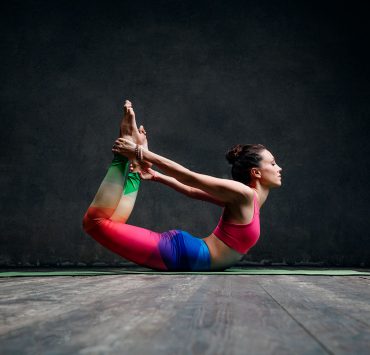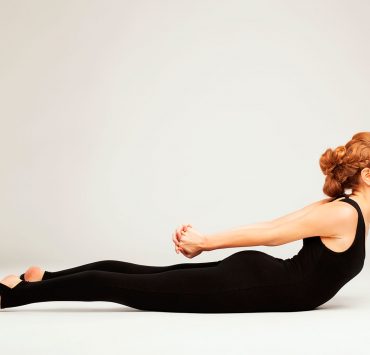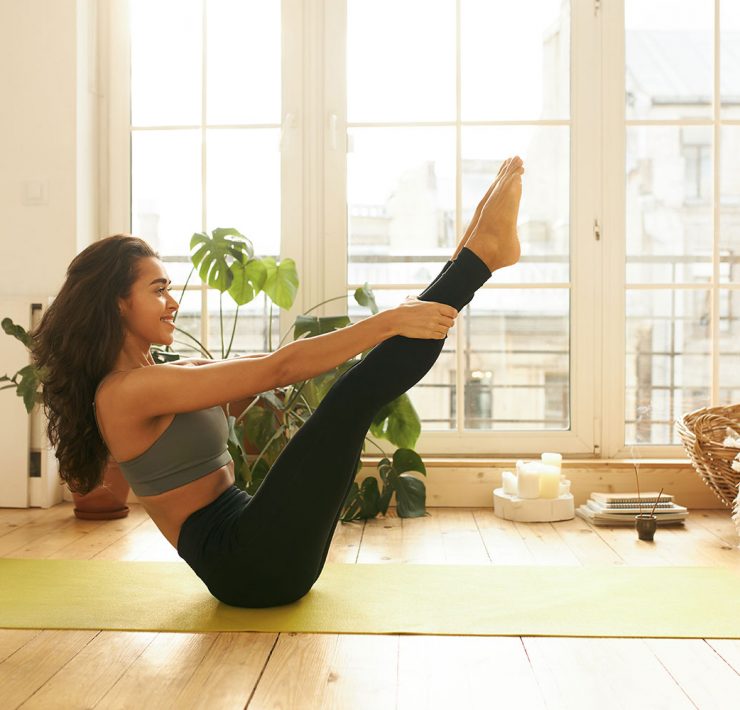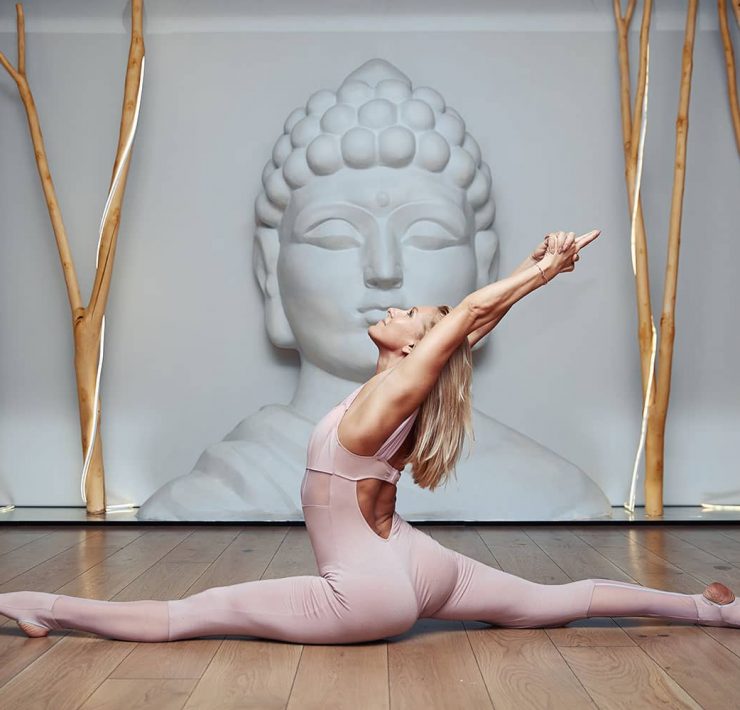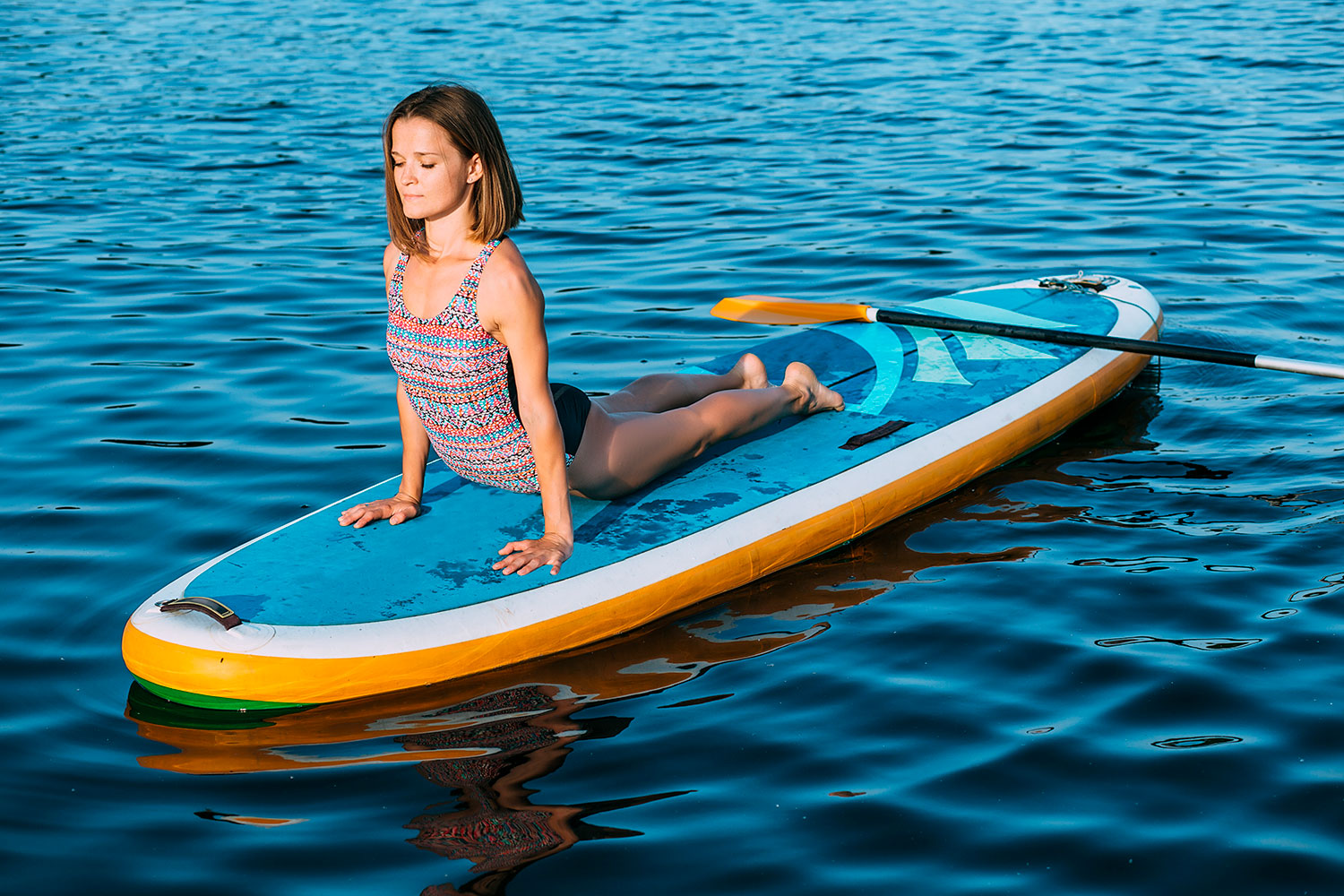
Having been a teacher’s assistant at over 50 yoga teacher…
If you’re an experienced yogi and want to try something new and daring, stand-up paddle board yoga (SUP) might be for you. Balancing on a paddleboard is hard work. While you try to stay afloat, you also resist the elements of wind and waves. The water changes your perception of movement, and will also shift your practice. Enjoy the serenity of floating on water, while engaging in a challenging asana practice that is not only instagram worthy, but great for your mind, body and soul. Here are 15 beautiful and relaxing paddleboard yoga poses with instructions and guidance that will take your yoga journey to the next level.
General Tips
Find your drishti – Your drishti is the most important aspect of being on a paddleboard. Because you are on water, a moving body, you are naturally prone to feeling unsteady. If your gaze is fixed on a non-moving point, like the horizon or something on land, your body will feel more grounded and stable.
Move slowly – Doing fast paced yoga on a paddleboard might land you in the water. Instead, opt for mindful movements and go even slower than you would on land. Approach these postures from a brand new perspective, and do not have expectations that they will necessarily feel and look like the ones on your mat.
Your board is your mat – Even though you aren’t on your mat, the paddleboard provides you with the same amount of room and space to explore postures. Familiarize yourself with the board and use specific markings or places as points of reference to help orient yourself.
Ready? Let’s go!
Adho Mukha Svanasana — Downward Facing Dog Pose

Come into table position on your board with your knees under your hips and hands under the shoulders.
With your palms pressed against the board and your toes tucked, send your hips high to the sky and straighten the legs. Press your heels towards the back.
Focus your eyes on the horizon behind you, in between your legs. Spread your fingers wide on the board and tent your hips up even more.
Take 10 deep inhales and exhales, and continue to hold this posture.
To release downward facing dog, lower your knees back to the earth in table position.
Prasarita Padottanasana — Wide-Legged Forward Bend

Find the center of the board and open your legs one leg length distance apart.
Feel the balance of the four corners of your feet, and slightly pigeon-toe your feet.
Bring the belly into the spine and tuck your pelvis forward. Place the hands on your hips.
Exhale, bend forward from the waist with a straight back. Stop when you are parallel to the water. On the next exhale, round the back and fold to your deepest bend.
Place your hands shoulder distance apart, level with your feet. Drop your head to the board and take 10 deep inhales and exhales.
To release, place the hands back on your hips and draw the spine up with your core engaged.
Bhujangasana — Cobra Pose

Lay on your belly on your board long ways. Bring the legs together behind you, and rest the tops of the feet on the board.
Place your hands on the board, underneath your shoulders. Bring your gaze to the top of your board, with your chin slightly tilted down.
Press your pelvis down. On the inhale, lift the chest, neck and head as you straighten your arms.
Drops your shoulders away from your ears, and lift your gaze to the third eye.
Hold posture for 10 breaths, with the entire body engaged. To release, bend the elbows and lower your body back to the board.
Tadasana — Mountain Pose

Stand in the middle of the paddleboard, with your feet hip distance apart.
Ground the four corners of each foot into the board, primarily the balls and heels.
With the arms down by your sides, point the fingertips down towards the water and open your hands away from you.
Find a neutral spine and gently guide your belly button inward. Draw your shoulder blades down and back, away from the ears.
Elongate the neck and lift the crown up to the sky. Take 2 minutes standing in tadasana, with eyes closed or open. Just breathe and notice what is present.
Urdhva Dhanurasana — Wheel Pose

Lay on your back. Bend the knees and place your feet on the board hip distance apart, close to the sitz bones.
Place your hands beside your head, fingers facing inwards. Engage both the palms and the feet firmly into the board.
Inhale, tilt your tailbone up and off the the board, firming your glutes.
Continue to lift the spine, press into the hands, and lift your upper back off the board. Bring your head up last as you extend the arms, and bring your gaze towards the horizon behind you.
To release, bend the elbows and lower one vertebrae at a time back to your board.
Anjaneyasana — Crescent Pose

Begin in tadasana on your board. Stagger your legs, one in front of the other, a leg length distance apart.
Squeeze the inner thighs together and tuck your tailbone down.
With both toes facing forward, press the back heel down to the board. Exhale, bend the front knee until your knee is directly above the ankle.
Inhale, lift the arms to the sky. Lift the gaze and the chest up and send the arms slightly back.
Hold Crescent Lunge for 10 breaths. To release, lower both arms, straighten the legs, and step back into Tadasana. Repeat on the other side.
Virabhadrasana II — Warrior II

Begin in tadasana again on your board. Step one leg back behind you and angle your foot 45 degrees out with the heel still down.
Turn your hips towards the long side of your board. To level them gently tuck your back hip towards the other hip.
Exhale, bend your front knee until it is directly over the ankle. Press into the side of your foot to open the knee away slightly.
Inhale, lift the arms up to shoulder height. Gaze over your front arm towards the horizon. Hold Warrior II for 10 breaths.
To release, lower the arms and step the back foot to the front foot. Repeat on the other side.
Ardha Kapotasana — Half Pigeon Pose

Come to table posture on your board. Bring your right knee into the chest and flip your foot towards the left wrist.
Place your lower leg down on the board. Straighten your left leg back behind you and rest the top of your foot on the board.
Lower your bent right leg down up to the thigh and hip, eventually resting on your sitz bones.
Bring your hands together in prayer position. Hold half pigeon for 10 breaths.
To release, place your hands back to the board and lift off of the bent leg. Return to table position and repeat this sequence on the left side.
Dhanurasana — Bow Pose

Begin on your belly. Bend your elbows and place your hands by the head.
Activate your lower body; squeeze thighs and press the pubic bone down into the board.
On an inhale, lift the chest off the board, head coming up last. Arms should be hovering over the board. Inhale again, lift the legs behind you.
When your chest and neck are fully open, bend the knees and open your legs slightly apart.
Lift the feet upward and reach behind you. Grab the outsides of both feet with your hands.
Continue to lift the legs and lift the upper body until your body resembles a bow shape. Press the pelvis into the board to protect the low back.
Hold posture for 10 breaths. Release grip of the feet and lower everything back down to the board.
Vrksasana — Tree Pose

Come to tadasana in the center of your paddleboard. Focus on a non-moving point at eye level, either in the distance or close to you.
Pour your weight into your right foot. Inhale, bend the left leg with the knee pointing to the side.
Place your foot on the inner thigh. Press the heel against your leg and press your leg against your heel.
Lift the spine tall, bring the hands to prayer, and continue the breath for 10 counts.
Lower your left foot back down to the board, and repeat on the other side.
Vasisthasana — Side Plank Pose

Begin in high plank position on your board.
Shift your feet so that you are resting on the outside of your right foot. Stack your left foot on top.
Place your left hand on your hip and open your body out to the left side. Focus on a point in the horizon.
Inhale, lift the left arm up to the sky. Lift your right hip up towards the sky. Breathe here for 5-10 counts.
Lower your arm back down and unstack your feet. Realign the body back to high plank position, and repeat this sequence on the other side.
Paripurna Navasana — Boat Pose

Sit on your board with your knees bent, feet on the board in front of you. Place the hands under the thighs right at the knee crease.
Inhale, come up onto the tip toes, and balance on your sitz bones for a few breaths.
Inhale again, and lift the legs until your calves are parallel with the board. Activate the core and lift your chest higher.
Straighten your legs if possible, and open your arms out in front of you. Continue to lift the chest and lift the legs higher, creating a deeper V shape with your body.
Hold your balance in boat pose for 5-10 breaths.
Ustrasana — Camel Pose

Kneel on your board with your knees hip distance apart and your thighs perpendicular to the water. Press your toes firmly into the board.
Rest your hands on your low back, palms below the natural curve with fingers pointing down over the buttocks.
Press your hands into the tailbone and push the tailbone towards the pubic bone. Inhale, lift your chest and head up to the sky.
Begin to drop your upper body back and press the pelvis forward, engaging your thighs to counter balance.
When you can no longer bend backwards, place your hands down to the heels. Take 10 deep inhales and exhales.
To release, place the hands back to the low back and lower the hips down to the heels. Lift your upper body back to center.
Ardha Matsyendrasana — Half Lord of the Fishes Pose

Begin in easy pose on the board. Lift your right leg and place the foot on the board on the outside of your left thigh.
Ground both sitz bones down into the board. Elevate the spine and place your left elbow on the outside of your right thigh.
Twist towards the right side, gazing over your back shoulder. Place the right hand directly on the board behind your low back. Hold posture here for 10 breaths, continuing to twist.
To release, untwist and release your left arm back. Return to easy pose, and repeat this sequence on the other side.
Savasana — Corpse Pose

Lay on your board on your back in supine position. Arms are down by your sides.
Open your legs slightly and let your toes fall outward. Open your palms up to the sky.
Draw your shoulders down away from your ears and relax all the muscles in the body.
Close your eyes and listen to your breath. Listen to the waves and any other sounds around you.
Then, completely withdraw your senses and intention of focus. Allow relaxation to take over as you let your body be cradled by the board.
Remain in savasana for at least 5 minutes, until as long as you’d like. Do this after a posture sequence to integrate your practice and let the body cool down.
Connecting with the water
Take your yoga practice to the next level and try this posture sequence on your paddle board. It incorporates all movements of the spine, with postures varying from easy to intermediate. These beautiful and relaxing postures will help you find your center on the water, while balancing on a large paddleboard. Practicing yoga on the water is a wonderful way to challenge your already thriving practice, and also connect you to the deeply spiritual element of floating on a moving surface. You may find that you, like the water, are prone to ups and downs, but within movement is a divine stillness that connects you deeper to yourself and your surroundings.
What's Your Reaction?
Having been a teacher’s assistant at over 50 yoga teacher trainings worldwide, Rebecca Rebecca has a firm grasp on the fine art of yoga and meditation. In her work, she carefully reflects on a vast expanse of knowledge to help others find peace in both body and mind.






